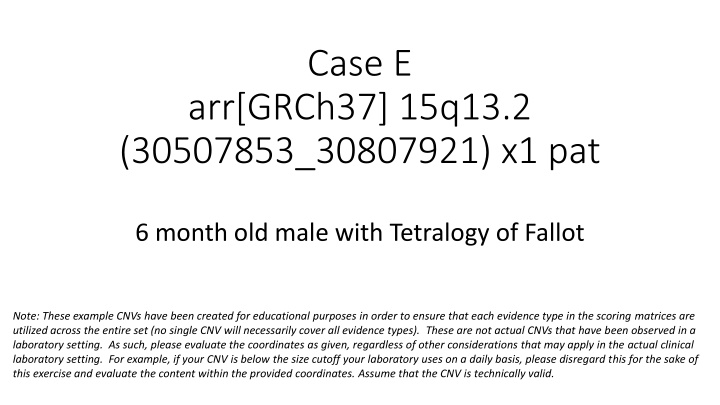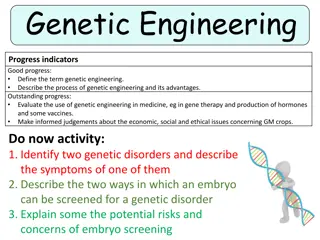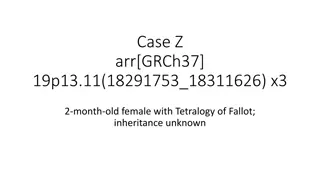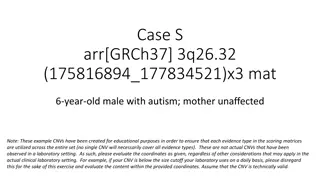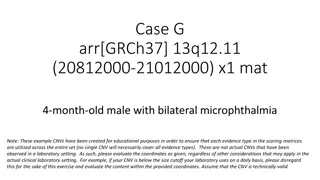Genetic Evaluation of 6-Month-Old Male with Tetralogy of Fallot
A 6-month-old male with Tetralogy of Fallot was assessed for a paternally inherited CNV at 15q13.2. The evaluation involved analyzing genes, overlap with established regions, haploinsufficiency predictors, gene number, and disease associations. The CNV contained 2 protein-coding genes without known disease associations. This detailed analysis contributes to understanding the genomic content in the context of the patient's condition.
Download Presentation

Please find below an Image/Link to download the presentation.
The content on the website is provided AS IS for your information and personal use only. It may not be sold, licensed, or shared on other websites without obtaining consent from the author.If you encounter any issues during the download, it is possible that the publisher has removed the file from their server.
You are allowed to download the files provided on this website for personal or commercial use, subject to the condition that they are used lawfully. All files are the property of their respective owners.
The content on the website is provided AS IS for your information and personal use only. It may not be sold, licensed, or shared on other websites without obtaining consent from the author.
E N D
Presentation Transcript
Case E arr[GRCh37] 15q13.2 (30507853_30807921) x1 pat 6 month old male with Tetralogy of Fallot Note: These example CNVs have been created for educational purposes in order to ensure that each evidence type in the scoring matrices are utilized across the entire set (no single CNV will necessarily cover all evidence types). These are not actual CNVs that have been observed in a laboratory setting. As such, please evaluate the coordinates as given, regardless of other considerations that may apply in the actual clinical laboratory setting. For example, if your CNV is below the size cutoff your laboratory uses on a daily basis, please disregard this for the sake of this exercise and evaluate the content within the provided coordinates. Assume that the CNV is technically valid.
Clinical Information arr[GRCh37] 15q13.2 (30507853_30807921) x1 pat 6 month old male with Tetralogy of Fallot Variant is paternally inherited; father is said to be unaffected Use the LOSS scoring metric
Section 1: Initial Assessment of Genomic Content Case E Genes Involved Would apply category 1A (contains protein-coding or other known functionally important elements), as this deletion includes protein-coding genes. 0 points; continue evaluation Total: 0 points
Section 2: Overlap with Established/Predicted HI or Established Benign Genes/Genomic Regions Case E ClinGen Curated Track Segmental Duplications CNV E is located in the 15q13 region, but does not overlap with any of the current curated recurrent regions. Note that it does fall within a cluster of segmental duplications. Total: 0 points
Section 2H: Haploinsufficiency Predictors Neither gene meets criteria for HI predictors. Total: 0 points
Section 3: Evaluation of Gene Number CNV E contains only 2 protein-coding genes (3A, 0 points). Total: 0 points
Section 4: Detailed Evaluation of Genomic Content As of April 2020, neither CHRFAM7A nor GOLGA8R have been associated with human disease per OMIM Basic literature search does not reveal any convincing evidence CNV E was located in a cluster of segmental duplications Check for evidence of population variation
GOLGA8R CHRFAM7A Approximate length of CNV E This population variant is similar in size and genomic content to CNV E. What is its frequency?
The variant has been observed in almost 2000 individuals (out of ~21,000), with an overall allele frequency of 9.08%.
Population Frequency The variant has passed quality filters. A sufficient number of alleles has been studied (>2000 alleles from a continental population). The variant has been observed within all studied populations, but is most frequent in Africans, with an allele frequency of 12.44%. This is too high to be a plausible cause for a rare anomaly such as Tetralogy of Fallot. Apply Category 4O, -1 points Total: -1 points
Similar variants are also observed in DGV Case E 1.72%
Section 5: Evaluation of Inheritance Pattern/Family History for Patient Being Studied Our patient is a 6-month-old with Tetralogy of Fallot Regardless of inheritance information, similar deletions are observed frequently in the general population, at frequencies too high to be a plausible cause for this phenotype. The variant is inherited from an unaffected father. This is not surprising, given the population frequency of the variant. The CNV can already be classified as benign on the basis of the population data, so it is unnecessary to assign additional negative points for inheritance. Total: -1 points
Conclusion Classification: Benign Similar deletions are observed in the general population at frequencies too high to be a plausible cause for Tetralogy of Fallot. Consider additional testing to investigate other potential causes for Tetralogy of Fallot in this individual.
